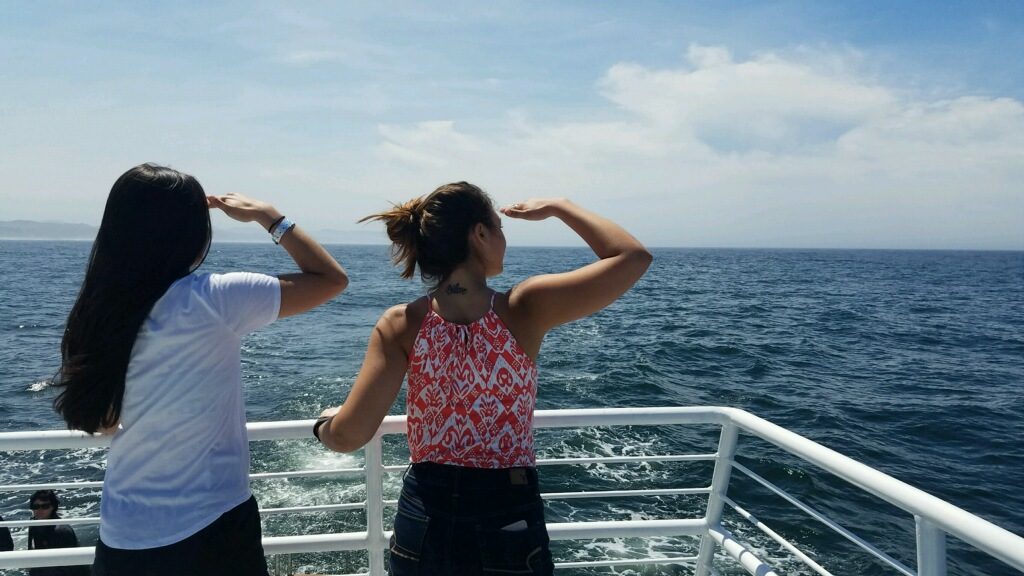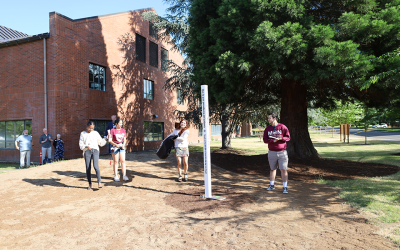It’s no secret that one of the biggest Western Oregon University selling points is its location. From its vantage point in the Mid-Willamette Valley, WOU is primed to dispatch students to day trips on the sandy beach shore, up snow-capped mountains or into lush forests with minimal travel time.
The WOU Outdoors Program, as part of Campus Recreation, regularly transports students to these locations, where they can get a dose of nature along with an opportunity to meet new people and stretch their legs.
The trips, usually two per term, are geared towards beginners, but students are free to make the outing their own, explained Assistant Director of Campus Recreation Programs Melissa Bergeland.
“People enjoy the opportunity to get to do this in a safe way, and it’s non-judgmental because we are all common adventurers,” she said. “It’s not like anyone has to keep up with any other person. You don’t have stay all together in a huge group. As long as there are at least two people, they can set their own pace.”
The phrase “common adventurer” sets the tone for excursions. Group leaders are not experts in biology or wilderness survival, they simply enjoy the outdoors and want to experience nature with fellow students.
Sierra Johnston, a senior who has led and participated in several Outdoors Program trips, explained the concept like this: “A common adventurer is someone who goes out into nature and experiences it. They have some knowledge of the outdoors. That’s not to say that they have any certifications or are there to lead an official tour.”

Johnston didn’t go with the group that hiked in Silver Falls State Park (and did yoga by a waterfall!) a few weeks ago, but she’ll be leading the second fall-term outing: a visit to Cascade Head north of Lincoln City on the coast.
“It’s a beautiful hike. There are different levels of difficulty for people, so if they don’t want to do the four or five mile hike, they can do the one or two mile hike,” said Johnston, a psychology major. “We have lots of flexibility for people and where they are at with their outdoor experience. Some people just want to look at the flowers, and some people want to go a (strenuous) trip. We try to accommodate all levels.”
Students and leaders generally leave WOU at 9 a.m. and are back by 5 p.m. Transportation is provided by the program, as is all necessary gear, such as trekking poles or snowshoes for the snow hikes. Campus Rec actually has a wide variety of adventure gear – think sleeping bags, backpacks, tents and daypacks –available to rent for very little cost, Bergeland said.

During any trip, there are just a few rules. First, participants are required to stay in groups of at least two for safety reasons. Second, everyone must follow the seven “leave no trace” guidelines, which include staying on trails and packing out everything that was packed in. Bergeland describes the practice as training students to be stewards of the environment. Johnston agrees.
“These (practices) help us coexist with the environment in a beautiful manner so that we can enjoy it and make sure others can enjoy it in the future,” she said.
Bergeland said Outdoors Program trips are especially popular with international students, who may desire to explore the state where they’ve come to study. But there are plenty of native Oregonians who participate as well, and they are just as happy to spend time in the beauty they may be more familiar with.
“It’s a lot of picture taking, I’ll be honest,” Johnston said with a laugh. “It gives everyone a great opportunity to get out and enjoy Oregon. I’m so glad they are able to enjoy our state. I grew up climbing Multnomah Falls since I was 6, so I personally love it, and I love sharing it with people who may not be as outdoorsy. Plus, (students ask) a lot of questions, which I love.”
The cost of each trip is generally around $10. Bergeland said the department works hard to keep the outings inexpensive to make them accessible to students. The remainder of the cost of trips is covered by various university funding resources. She’d like to add more trips in the future, as the budget allows, such as overnight trips to farther-flung places. In the meantime, the program aims to present a variety of opportunities in the state.
“The hope is that our program will continue to grow and we’ll continue to be able to build that into our budget and we’ll be able to add more programs as we start to see more people getting involved,” she said. “We try to keep it fresh and not stale. We try not to do the same thing over and over again. Right now we are in a cycle of doing the same trips for two years, and then we will talk about how add new things.”
Bergeland and Johnston agreed the most popular adventures are the whale-watching trips that are scheduled for spring term. The groups travel to the coast, where a charter boat takes them offshore to – hopefully — get a closer look at migrating whales.
“We’ve found a (charter boat) company that does a great job with educating in a fun way so you still get to learn stuff, which is great,” Bergeland said. “Being involved in the higher education system, we always want students to be learning. You get more out of it.”

Other scheduled trips include a hike in the famed Opal Creek Wilderness and a visit to White River Sno Park. The program had planned an outing to Eagle Creek, but that likely will be postponed as the area recovers from devastating wildfires last summer. A planned trip to Eagle Creek last spring had to be rerouted to Multnomah Falls because the parking lot was jam-packed when the van arrived. Despite the change of plans, Johnston remembers the trip, and one particular student, fondly.
“He was the most happy-go-lucky student the whole time. (He was) kind of goofy and really loved being outdoors,” she recalled with a chuckle. “But every time we took a photo, he was like stone-faced. When I asked him why he wouldn’t smile, he said ‘No. Only serious.’”
Johnston has loved all her Outdoor Program adventures, she said, even when it was pouring rain. The trips happen regardless of the weather, Bergeland explained, and in Oregon, one never knows what kind of mood Mother Nature will be in.
Johnston encourages students who want to lead outings or just participate to seek more information at the Peter Courtney Student Health and Wellness Center. The advantages are numerous, with fun being at the top of the list.
“It gives (students) the opportunity to co-mingle with other students and build those bonds,” Johnston said. “You can enhance yourself, relieve stress and even learn to run the trips yourselves.”

Bergeland added some other advantages: “The connection to the out of doors has so many benefits: mentally, physically, emotionally. There are all these benefits to just being out in nature and seeing that. One of our participants on the Silver Falls hike a few weeks ago had never seen a waterfall before in her life. She’s 22. The fact that someone had not seen a waterfall just blew me away. To be able to offer that kind of experience to someone, to be able to give them that sort of ‘aha’ moment, that’s one of the things that keeps us going.”
To learn more about the program and planned outings, visit the Outdoor Program website.






0 Comments